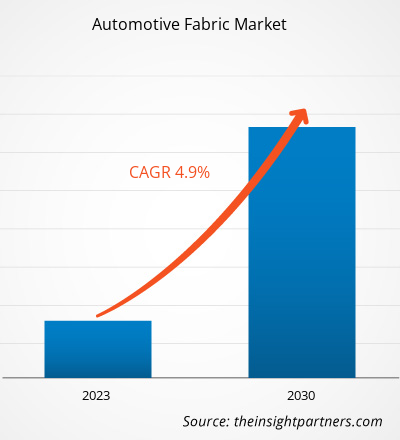[研究报告] 2022 年汽车面料市场规模为 415.1383 亿美元,预计到 2030 年将达到 607.2234 亿美元;预计 2022 年至 2030 年的复合年增长率为 4.9%。
市场分析
汽车面料包括机织、非织造和涂层三种形式。这类织物材料非常灵活,具有抗紫外线和抗冷裂、耐用性和轻量化等特点。汽车面料提供舒适的座椅体验,并提升整体的美感体验。技术进步以及对卓越舒适度和高品质材料的偏好强烈推动了市场的增长。随着汽车产量的增加,对汽车配件的需求也随之增加,预计这将有助于未来几年汽车面料市场的增长。
增长动力和挑战
汽车制造能力的提升和对电动汽车需求的不断增长是推动全球汽车行业增长的几个因素。汽车是欧洲领先的产业之一,因为它对包括德国、意大利和英国在内的欧洲国家的GDP贡献巨大。由于消费者对质量和美观度的重视,对汽车内外饰美观度和性能的开发日益重视,这推动了对汽车面料的需求。各国政府都实施了严格的安全法规,包括强制安装和使用安全带、安全气囊和防抱死制动系统,以提高车内安全性,这推动了对高性能和安全汽车面料材料的需求。因此,汽车产量的不断增长以及人们对汽车美观日益关注,推动了汽车面料市场的增长。
聚氯乙烯 (PVC) 和聚氨酯 (PU) 是制造合成皮革最常用的两种合成塑料聚合物。使用塑料制造合成皮革的工艺并不环保。大多数合成皮革中使用的塑料生产过程通常是一个相对耗能且充满化学物质的过程,也会产生大量废弃物。因此,PVC 和 PU 的有害影响,加上合成皮革的耐用性不如皮革,抑制了汽车面料市场的增长。
自定义此报告以满足您的要求
您将免费获得任何报告的定制,包括本报告的部分内容,或国家级分析、Excel 数据包,以及为初创企业和大学提供超值优惠和折扣
汽车面料市场: 战略洞察

-
获取本报告的主要市场趋势。这个免费样本将包括数据分析,从市场趋势到估计和预测。
报告细分与范围
《2030年全球汽车面料市场分析与预测》是一项专业且深入的研究,重点关注全球市场趋势和增长机遇。本报告旨在概述全球市场,并根据零部件、材料和地域进行详细的市场细分。报告提供了全球汽车面料消费的关键统计数据,以及主要地区和国家的需求。此外,报告还对影响主要地区和国家汽车面料市场表现的各种因素进行了定性评估。报告还对汽车面料市场的主要参与者及其关键战略发展进行了全面分析。本报告还包括市场动态分析,以帮助识别关键驱动因素、市场趋势和盈利机会,从而有助于识别主要收入来源。
生态系统分析和波特五力模型分析提供了全球汽车面料市场的 360 度视角,有助于了解整个供应链以及影响市场增长的各种因素。
细分分析
全球汽车面料市场根据组件和材料进行划分。根据组件,汽车面料市场细分为地毯、车顶内衬、引擎盖内衬、隔热材料、座椅套材料等。根据材料,市场细分为纺织品、人造革、真皮和人造绒面革。此外,地毯细分市场在 2022 年占据了汽车面料市场的很大份额。地毯面料完全由针刺、无纺布或簇绒面料设计而成。聚酯纤维、聚酰胺纤维、聚丙烯纤维和芳纶纤维是地毯设计中首选的纤维材料,可提升汽车内饰的质感。车顶内衬采用经编针织面料制成,触感柔软,外观统一,并能提升整体内饰风格。引擎盖内衬由一层薄薄的隔热材料和适当的隔音元件组成,可防止因引擎盖隔热性能不佳而产生的噪音。隔音隔热性能是各种汽车部件(例如发动机罩、底盘、发动机罩等)的必备特性之一。三层压聚酯纤维被用作多种汽车座椅的面料。
从材料来看,纺织品在2022年占据了相当大的份额。汽车纺织品在轿车、火车、公共汽车和其他车辆中有着广泛的应用。汽车纺织品由不同类型的纺织成分组成,例如纱线纤维、长丝和其他织物。人造皮革,也称为仿皮或合成皮革,采用聚氯乙烯 (PVC) 或聚氨酯 (PU) 制成。真皮被认为是汽车行业用于内饰部件的一种昂贵织物材料。合成绒面革的需求持续增长,常用于设计高端汽车部件。随着消费者生活方式的转变以及对豪华驾驶和汽车共享服务的日益青睐,全球人造绒面革市场蓬勃发展。
区域分析
本报告详细概述了全球汽车面料市场,涵盖五大主要区域——北美、欧洲、亚太地区 (APAC)、中东和非洲 (MEA) 以及南美洲和中美洲。亚太地区占据了汽车面料市场的很大份额,2022 年的市场价值超过 200 亿美元。亚太地区是汽车制造中心,拥有大量国内外企业在该地区运营。国际汽车制造商组织 (IOM) 的报告指出,2021 年亚太各国生产了约 4673 万辆汽车。预计到 2030 年,欧洲市场规模将超过 100 亿美元。汽车工业是欧洲的主要产业,为包括德国、英国和意大利在内的许多欧洲国家的 GDP 做出了巨大贡献。汽车织物广泛应用于汽车地毯、后备箱区域、内饰、隔音和隔热。预计北美汽车织物市场在 2022 年至 2030 年期间的复合年增长率将达到约 4%。北美拥有奥迪股份公司、拜耳汽车公司、Stellantis NV、福特汽车公司、本田汽车公司、现代汽车公司、梅赛德斯奔驰和大众集团等知名汽车制造商。因此,预计汽车行业的扩张将在未来几年推动北美对汽车面料的需求。
行业发展和未来机遇
以下列出了汽车面料市场主要参与者采取的各种举措:
- 2023年9月,Apex Mills收购了位于美国斯图尔特的HanesBrands Inc.工厂。此次收购有助于扩大弹性体针织、染色和整理能力。
- 2022年3月,李尔公司完成了对罗马公司Thagora Technology SRL的收购。此次收购帮助李尔公司在其竞争力中增加了可扩展的智能制造技术。
- 2022年2月,李尔公司宣布完全收购康斯博格汽车的内饰舒适系统业务部门。此次收购增强了李尔的座椅零部件产能,并扩大了产品供应。
汽车面料市场区域洞察
The Insight Partners 的分析师已详尽阐述了预测期内影响汽车面料市场的区域趋势和因素。本节还探讨了北美、欧洲、亚太地区、中东和非洲以及南美和中美洲的汽车面料市场细分和地域分布。
汽车面料市场报告范围
| 报告属性 | 细节 |
|---|---|
| 市场规模 2022 | US$ 41.51 Billion |
| 市场规模 2030 | US$ 60.72 Billion |
| 全球复合年增长率 (2022 - 2030) | 4.9% |
| 历史数据 | 2020-2021 |
| 预测期 | 2023-2030 |
| 涵盖的领域 |
By 部件
|
| 覆盖地区和国家 |
北美
|
| 市场领导者和主要公司简介 |
|
汽车面料市场参与者密度:了解其对业务动态的影响
汽车面料市场正在快速增长,这得益于终端用户需求的不断增长,而这些需求的驱动因素包括消费者偏好的不断变化、技术进步以及对产品优势的认知度不断提高。随着需求的增长,企业正在扩展产品线,不断创新以满足消费者需求,并抓住新兴趋势,从而进一步推动市场增长。

- 获取 汽车面料市场 主要参与者概述
新冠疫情的影响/地缘政治局势的影响/经济衰退的影响
新冠疫情爆发前,全球许多国家都报告了经济增长。主要制造商投资于汽车面料的研发。他们还专注于通过并购策略扩大地域覆盖范围,以满足广泛的客户群。新冠疫情爆发前,由于汽车行业需求不断增长,汽车面料生产商的产量稳步增长。汽车面料制造商更加注重开发环保、耐用且易于清洁的面料。据美国国际贸易委员会 (USITC) 统计,由于汽车行业高度脆弱,2020 年美国汽车销量较 2019 年下降了 15%。疫情期间,供应链中断、原材料和劳动力短缺以及运营困难造成供需缺口,对汽车面料市场增长产生了不利影响。制造商报告称,从供应商处采购原材料和配料面临挑战,从而影响了汽车面料的生产率。
此外,供应链严重中断和技术工人有限造成的产量短缺,在许多地区,尤其是亚太地区、欧洲和北美,造成了供需缺口。由于汽车行业需求波动,上述地区也出现了供需缺口。2021 年,疫苗接种率的提高促进了各国总体情况的改善,为化学和材料行业创造了有利环境。随着生产和汽车行业公司的销售业务。
竞争格局和主要公司
Lear Corp、Bader GmbH & Co KG、BOXMARK Leather GmbH & Co KG、AUNDE Group SE、Grupo Empresarial Copo SA、Classic Soft Trim Inc、Dual Borgstena Textile Portugal Unipessoal Lda、Shawmut Corp;Apex Mills Corp、Seiren Co Ltd 是汽车面料市场的主要参与者。
- 历史分析(2 年)、基准年、预测(7 年)及复合年增长率
- PEST和SWOT分析
- 市场规模、价值/数量 - 全球、区域、国家
- 行业和竞争格局
- Excel 数据集
近期报告
相关报告
客户评价
购买理由
- 明智的决策
- 了解市场动态
- 竞争分析
- 客户洞察
- 市场预测
- 风险规避
- 战略规划
- 投资论证
- 识别新兴市场
- 优化营销策略
- 提升运营效率
- 顺应监管趋势






















 获取免费样品 - 汽车面料市场
获取免费样品 - 汽车面料市场